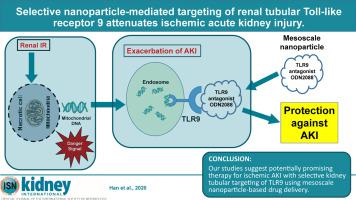Kidney International ( IF 19.6 ) Pub Date : 2020-02-22 , DOI: 10.1016/j.kint.2020.01.036 Sang Jun Han 1 , Ryan M Williams 2 , Vivette D'Agati 3 , Edgar A Jaimes 4 , Daniel A Heller 5 , H Thomas Lee 1

|
We developed an innovative therapy for ischemic acute kidney injury with discerning kidney-targeted delivery of a selective Toll-like receptor 9 (TLR9) antagonist in mice subjected to renal ischemia reperfusion injury. Our previous studies showed that mice deficient in renal proximal tubular TLR9 were protected against renal ischemia reperfusion injury demonstrating a critical role for renal proximal tubular TLR9 in generating ischemic acute kidney injury. Herein, we used 300-400 nm polymer-based mesoscale nanoparticles that localize to the renal tubules after intravenous injection. Mice were subjected to sham surgery or 30 minutes renal ischemia and reperfusion injury after receiving mesoscale nanoparticles encapsulated with a selective TLR9 antagonist (unmethylated CpG oligonucleotide ODN2088) or mesoscale nanoparticles encapsulating a negative control oligonucleotide. Mice treated with the encapsulated TLR9 antagonist either six hours before renal ischemia, at the time of reperfusion or 1.5 hours after reperfusion were protected against ischemic acute kidney injury. The ODN2088-encapsulated nanoparticles attenuated renal tubular necrosis, inflammation, decreased proinflammatory cytokine synthesis. neutrophil and macrophage infiltration and apoptosis, decreased DNA fragmentation and caspase 3/8 activation when compared to the negative control nanoparticle treated mice. Taken together, our studies further suggest that renal proximal tubular TLR9 activation exacerbates ischemic acute kidney injury by promoting renal tubular inflammation, apoptosis and necrosis after ischemia reperfusion. Thus, our studies suggest a potential promising therapy for ischemic acute kidney injury with selective kidney tubular targeting of TLR9 using mesoscale nanoparticle-based drug delivery.
中文翻译:

选择性纳米颗粒介导的肾小管 Toll 样受体 9 靶向可减轻缺血性急性肾损伤。
我们开发了一种用于缺血性急性肾损伤的创新疗法,在遭受肾缺血再灌注损伤的小鼠中,选择性地靶向肾脏递送选择性 Toll 样受体 9 (TLR9) 拮抗剂。我们之前的研究表明,肾近端肾小管 TLR9 缺陷的小鼠可免受肾缺血再灌注损伤,这表明肾近端肾小管 TLR9 在产生缺血性急性肾损伤中起关键作用。在这里,我们使用了 300-400 nm 基于聚合物的中尺度纳米粒子,在静脉注射后定位到肾小管。在接受包裹有选择性 TLR9 拮抗剂(未甲基化 CpG 寡核苷酸 ODN2088)的中尺度纳米颗粒或包裹阴性对照寡核苷酸的中尺度纳米颗粒后,对小鼠进行假手术或 30 分钟肾缺血和再灌注损伤。在肾缺血前 6 小时、再灌注时或再灌注后 1.5 小时用封装的 TLR9 拮抗剂治疗的小鼠可免受缺血性急性肾损伤。包裹 ODN2088 的纳米颗粒可减轻肾小管坏死、炎症、减少促炎细胞因子合成。与阴性对照纳米颗粒处理的小鼠相比,中性粒细胞和巨噬细胞浸润和凋亡、DNA 片段化和半胱天冬酶 3/8 活化减少。综合起来,我们的研究进一步表明,肾近端肾小管 TLR9 激活通过促进缺血再灌注后肾小管炎症、细胞凋亡和坏死而加剧缺血性急性肾损伤。因此,我们的研究表明了一种潜在的有前景的缺血性急性肾损伤治疗方法,即使用基于中尺度纳米颗粒的药物递送选择性肾小管靶向 TLR9。



























 京公网安备 11010802027423号
京公网安备 11010802027423号